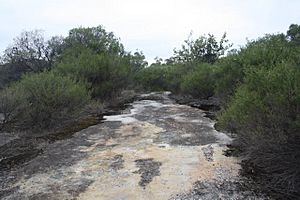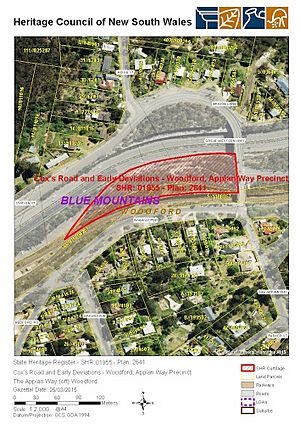Cox's Road and Early Deviations - Woodford, Appian Way Precinct facts for kids
Quick facts for kids Cox's Road and Early Deviations - Woodford, Appian Way Precinct |
|
|---|---|
 |
|
| Location | The Appian Way (off), Woodford, City of Blue Mountains, New South Wales, Australia |
| Built | 1814–1825 |
| Architect | William Cox |
| Official name: Cox's Road and Early Deviations - Woodford, Appian Way Precinct; Bathurst Road; Old Bathurst Road; Coxs Road | |
| Type | State heritage (complex / group) |
| Designated | 25 March 2015 |
| Reference no. | 1955 |
| Type | Road |
| Category | Transport - Land |
| Builders | William Cox; Convict Road Party |
| Lua error in Module:Location_map at line 420: attempt to index field 'wikibase' (a nil value). | |
The Cox's Road and Early Deviations - Woodford, Appian Way Precinct is a very old road in the Blue Mountains of New South Wales, Australia. It was built a long time ago, between 1814 and 1825, by a man named William Cox and a team of workers, many of whom were convicts. This road is also known as Bathurst Road, Old Bathurst Road, or Coxs Road. Today, it is a special heritage site, listed on the New South Wales State Heritage Register since 2015.
Contents
Building Australia's First Mountain Road
In 1813, explorers found a way across the Blue Mountains. This opened up new lands for European settlement. Governor Lachlan Macquarie, who was in charge of the colony, decided a proper road was needed. He wanted a carriage road built from Emu Ford to Bathurst, which is about 101.5 kilometres (63 miles) away.
This amazing road was built in just six months, between 1814 and 1815! Most of the workers were convicts. Building this road was a huge challenge. It was the first road built by Europeans across the Blue Mountains.
The Original Inhabitants
Before Europeans arrived, the Dharug, Gundungurra, and Wiradjuri Aboriginal people had lived on these lands for thousands of years. They had their own paths and routes through the mountains.
Who Was William Cox?
William Cox was born in England in 1764. He came to New South Wales in 1800. In 1810, he became a Chief Magistrate in Windsor. In 1814, Governor Macquarie chose him to lead the important project of building the road over the Blue Mountains. Cox passed away in 1837.
How the Road Was Built
William Cox and his team worked in the Woodford area in September 1814. Building the road was very basic and tough. They had to clear huge amounts of rock. Sometimes, they used the flat rock as the road itself. Where the ground was softer, they marked the road with rows of broken stones.
The workers cleared trees and large rocks. They made the road as flat as possible, cutting into hillsides and building up low areas when needed. Cox wrote about the road building in his journal. He noted that three areas were especially hard to build through: Linden to Woodford, Wentworth Falls, and the steep descent at Mount York.
What Remains of Cox's Road Today
The Appian Way Precinct is one of the last parts of Cox's Road that you can still see today. It shows how the road was cut into the rocky ridge in 1814. Later, in the 1830s, a new road was built nearby, which replaced parts of Cox's original road.
Over the years, other big projects changed the area. In the 1860s, a railway line was built next to Cox's Road. This railway was later used for the Great Western Highway. In 1896, another railway cutting was made, which cut off part of Cox's Road. Even with all these changes, a small section of the 1814 road still survives.
What the Road Looks Like
Governor Macquarie told William Cox to build a simple cart road. It needed to be at least 12 feet (3.7 metres) wide so two carts could pass. The area around the road had to be cleared for 20 feet (6.1 metres) on each side.
Today, the section of Cox's Road near The Appian Way in Woodford is a wide, flat stone path. You can see where it curves gently between the railway and highway cuttings. There's a large section of rock that was used as the road surface.
At one end, the road has a cutting about 1 metre (3.3 feet) high. You can still see marks from the tools used to cut the rock. Further along, there's a low stone wall, about 45 centimetres (1.5 feet) high, that supported the road. There's even a small, simple stone culvert (a tunnel for water) about 40 centimetres (1.3 feet) wide. This culvert might have been added later, as part of improvements to the road.
Near the road, there are also remains of a small stone structure, about 2 metres (6.6 feet) by 1 metre (3.3 feet). Experts think it might have been a storage area for tools or supplies during the road building.
Other Parts of Cox's Road
The State Heritage Register lists six main sections of Cox's Road that are still visible today:
- Cox's Road and Early Deviations - Linden, Linden Precinct
- Cox's Road and Early Deviations - Woodford, Old Bathurst Road Precinct
- Cox's Road and Early Deviations - Woodford, Appian Way Precinct
- Cox's Road and Early Deviations - Mount York, Cox's Pass Precinct
- Cox's Road and Early Deviations - Hartley, Clarence Hilly Range / Mount Blaxland Precinct
- Cox's Road and Early Deviations - Sodwalls, Fish River Descent Precinct
Road Condition Today
Most of the road is still in good condition. You can see many original features from 1814, like the flat rock pavement, low stone walls, and rock cuttings. There's also the small stone structure, which is important for understanding the road's history.
Why Cox's Road is Important
The parts of Cox's Road that still exist are very important to the history of New South Wales. It was the first road built across the Blue Mountains by Europeans. This road was a big step after the explorations by Gregory Blaxland, William Lawson, and William Wentworth. It showed that the natural barrier of the Blue Mountains could be overcome.
This road helped open up the land beyond the mountains for new towns and farms. Sadly, this also led to Aboriginal people losing their traditional lands.
A Chance for Freedom
William Cox was known for being fair to his workers. Many of the convicts who helped build the road were given pardons or "Tickets of Leave" (which meant they could work for themselves). This was a huge reward for their hard work.
How the Road Was Built
The remaining parts of the road show how quickly and simply Cox's team worked. They used basic tools and techniques to mark, cut, and shape the road. By looking at Cox's Road and other old roads, we can learn about different road-building styles from the colonial period.
Historical Significance
Cox's Road is important because it's physical proof of the first road built across the Blue Mountains. It shows how the colony of Sydney grew and how European settlement expanded into western New South Wales. The road also represents Governor Macquarie's dream of opening up the interior of Australia. It led to the founding of Bathurst, the first inland settlement in New South Wales, in 1815.
Important People
The road is strongly connected to Governor Lachlan Macquarie, who ordered its construction. It's also linked to William Cox, who led the building project. The convicts who worked on the road to gain their freedom are also an important part of its story. Cox's success in building the road quickly and safely showed his great leadership skills.
Technical Achievements
The surviving sections of Cox's Road are important for showing early road-building techniques from before the 1820s. They demonstrate how people built roads using simple tools and skills. Later improvements to the road also show how techniques changed over time. The Appian Way Precinct is a great example of early road building, with its cuttings, stone pavements, and small culvert.
Community Connection
Cox's Road is important to many people today. There's a lot of interest in visiting and learning about it, especially for cultural tourism and education. Many community groups and local governments celebrate the road's history. It's also very special to the descendants of William Cox.
Learning from the Past
The different parts of Cox's Road can teach us a lot about road building in the early 1800s. They show the conditions of the time and how exploration and development happened. The road represents a big achievement in engineering for its time. Some parts of the road have great potential for archaeological research, meaning we can still discover new things about them.
A Rare Example
Cox's Road is a rare example of early colonial road building in New South Wales. It shows how roads were built before the more advanced techniques of the 1820s and 1830s were developed.


